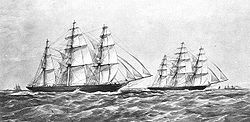Ariel (ship)
|
The Taeping and the Ariel
|
||||||||||||||||
|
||||||||||||||||
|
||||||||||||||||
|
||||||||||||||||
The Ariel was a three-masted full ship , which was constructed in 1865 in composite construction by Robert Steele & Co. from Greenock . She has been called one of the fastest Chinese clipper ships alongside her sister ship Sir Lancelot .
history
The Ariel was one of the extreme clippers . It was made in the composite construction method , which was new at the time, in which wooden planking was applied to a frame structure made of iron. This design was unusual until 1850 and was only used very rarely after 1885 because the all-metal design prevailed. During this period, sailing ships with outstanding sailing performance were produced. A large number of these ships were built in Scotland just for the expanding and very profitable tea trade with China. Their sole purpose was to bring the freshly harvested Chinese tea to the United Kingdom . The cost of building the Ariel in 1865 was £ 15,350, a substantial sum at the time. However, the ship met expectations, so on her third voyage under the command of Captain Keay on May 30, 1868 at 10.30 a.m., she left Fuzhou on China's southeast coast with a cargo of 554,076 kilograms of tea and arrived on September 6 after a crossing of only 99 days in London and was stuck in the East India Docks at 10.15 a.m., which brought in a multiple gain over construction and operating costs. She gained particular fame through the legendary tar race of 1866 , during which she reached the East India Docks in London after 99 days with only 20 minutes difference after the taeping .
During a trip from London to Sydney in 1872, the ship was probably lost without survivors after rounding the Cape of Good Hope in the Southern Ocean .
literature
- Tony Gibbons: The World of Ships. Bassermann Verlag 2007, ISBN 978-3-8094-2186-3 .
- Wolfgang Hölzel: Clipper ships of the 19th century VEB Hinstorff Verlag Rostock 4th edition 1987, ISBN 3-356-00145-0
